There are plenty of sharks in the Maldives: the predatory fish can be admired in the atoll kingdom, in the lagoon of the islands, on the house reefs and on almost every dive. Snorkelers can also discover the animals - and you can even see them from land. I have had my own experiences with these graceful creatures. Which shark species can you see while diving and snorkeling in the Maldives? And are they dangerous? I'm also looking into the question of which animals in the Maldives are really really dangerous - I've already had bad acquaintances with them. This much can be revealed in advance: it's not the sharks.
The Maldives are one of the most beautiful travel destinations in the world. Going on a luxury vacation on the resort island, indulging yourself in every way, lying on the beach and going for a swim in the lagoon - vacation could hardly be nicer. In my Travel report Maldives I would like to introduce you to the island paradise in more detail.
If you are looking for luxury and seclusion on an exquisite beach holiday, the island's kingdom is the right place for you. Vacationers who come to the Maldives usually want to spend a lot of time in the water: bathing, swimming, snorkeling and often diving. But many travelers ask themselves: Are there sharks in the Maldives? And if so, are they dangerous when swimming?
You are almost certain to encounter sharks in the Maldives
I can assure you this much at this point: The Maldives is one of the places in the world where you can almost be sure to see sharks. If you are vacationing on a resort island and staying in a water villa, you only need to look from the terrace and you can often spot sharks.
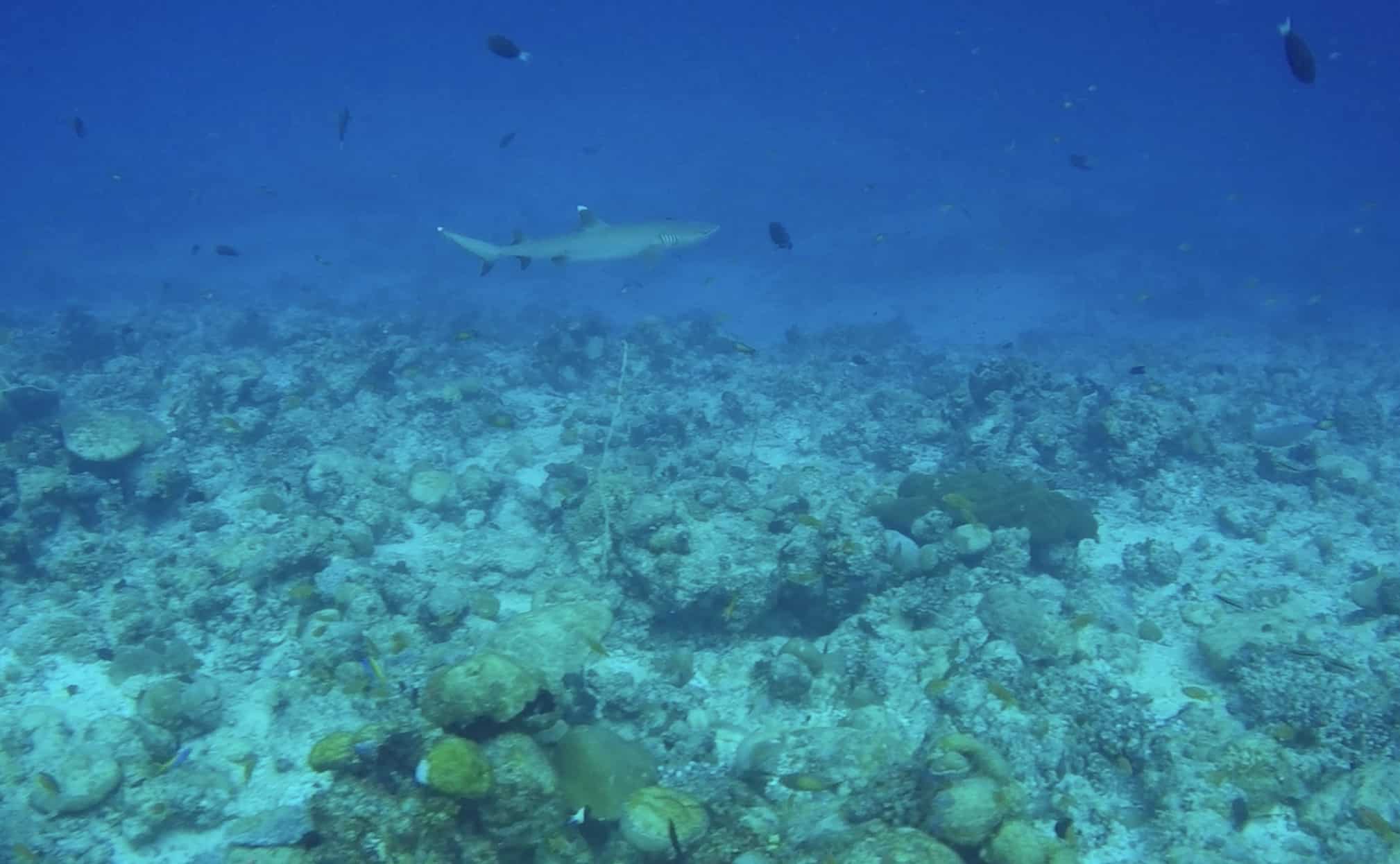
The predatory fish - just like turtles - come into the lagoons that mostly surround the islands. When I visited the Maldives, I always traveled with the SUP board and could see the sharks circling under my board. That was really impressive.
Some beachgoers and swimmers are afraid of sharks
The sharks of the Maldives – this is a controversial and complex topic. While many swimmers are afraid of the predatory fish, divers and snorkelers come to the realm of the atolls to find different things Shark species to be able to see at all. A Maldives diving holiday without sharks is only half a holiday. The big advantage of diving in the Maldives is that you can see sharks on almost every dive. And that is often a real highlight for divers and snorkelers.
On my Maldives travel like during my stays in Coco Bodu Hithi and Coco Palm Dhuni Kolhu I saw quite a few sharks. The predatory fish rushed under my SUP board while swimming, snorkeling, diving - and even stand-up paddling in the lagoon.
Video – Sharks of the Maldives
Most Maldivian sharks are reef sharks
In most cases these are whitetip reef sharks or blacktip reef sharks, smaller shark species that are quite shy and circle you from a greater distance when diving. When you're in the Maldives, you're most likely to encounter these animals while snorkeling and diving.
All other sharks in the Maldives are less common and you have to search for them or be very lucky. Reef sharks also include gray reef sharks and blacktip reef sharks. Those who want to see larger sharks are most likely to spot the whale shark. An encounter with the harmless whale sharks, which only eat plankton, is one of the highlights of every Maldives diving trip. But you have to come specifically between May and November and look for the right place - otherwise it will be very difficult to spot whale sharks in the Maldives.
Book your well-deserved vacation now!
Book your dream vacation now at favorable conditions on the renowned booking portal HolidayCheck – top rated by Stiftung Warentest (01/2024). Click and browse now!

Related Articles
The most important shark species in the Maldives
If you are a shark fan, you can look forward to your visit to the Maldives. The Kingdom of the Islands is truly one of the destinations where you are almost guaranteed to encounter the predatory fish. At the Diving in the Maldives you can find the graceful creatures on many dives. In many other parts of the world, stocks have been so depleted that the... animals are almost extinct.
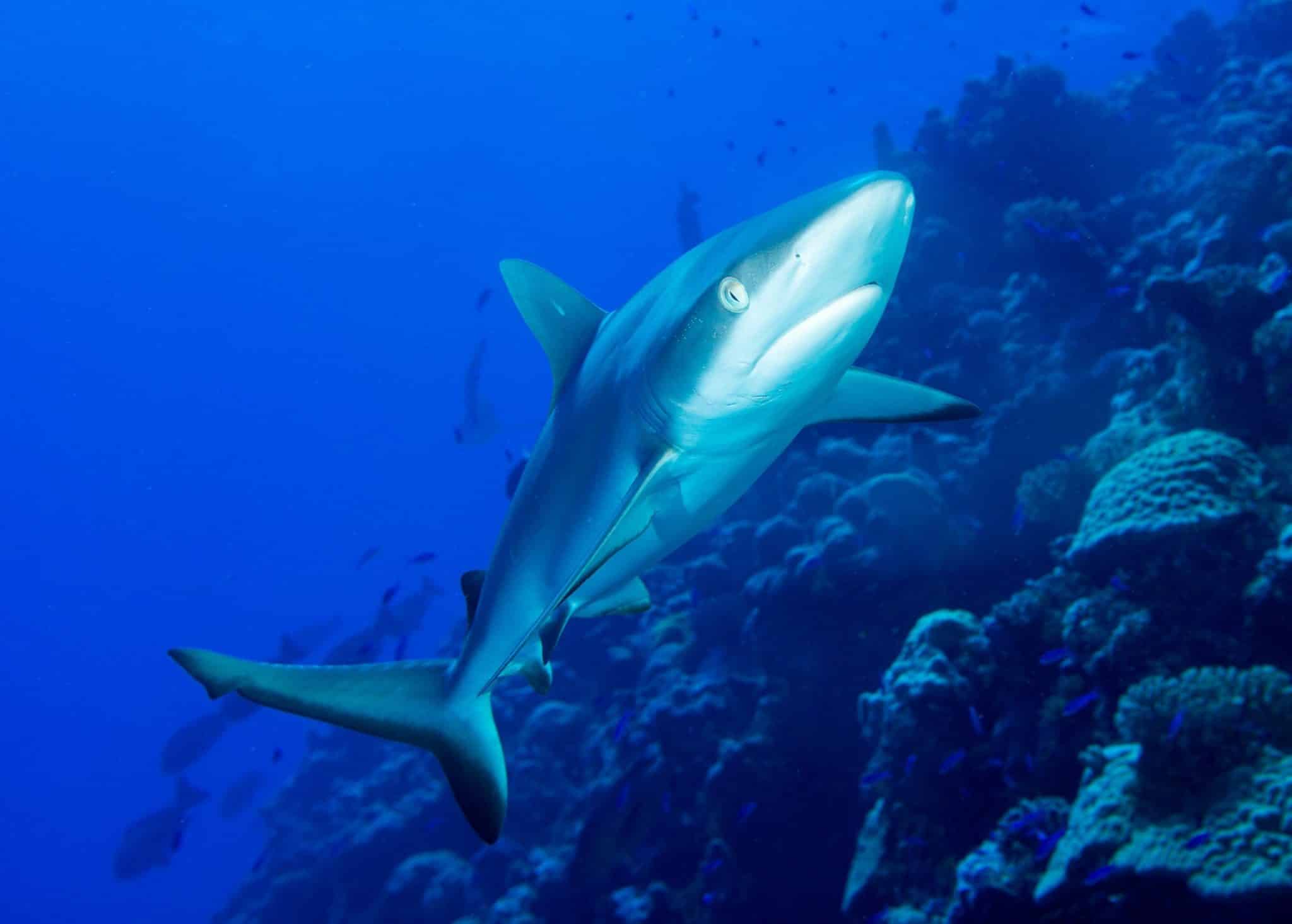
The shark species you can see in the Maldives include many of the typical species found in the Red Sea or even in Thailand happen. Reef sharks are the most common everywhere - especially whitetip reef sharks. But the whale shark is also one of the fish that divers and snorkelers want to see. Below we have listed the shark species in the Maldives that are at least relatively common.
1. Whale shark (Rhincodon typus)
The whale shark is a fascinating animal that will impress you with its size, appearance and behavior. Let's find out more about him together. It is the largest fish in the world. It is a shark, but it looks very different from most of its relatives. It has a broad, flat head, a long, flattened body and a horizontal caudal fin. Its skin is gray or brown with white spots and stripes. These patterns are unique to each whale shark and help researchers identify them.
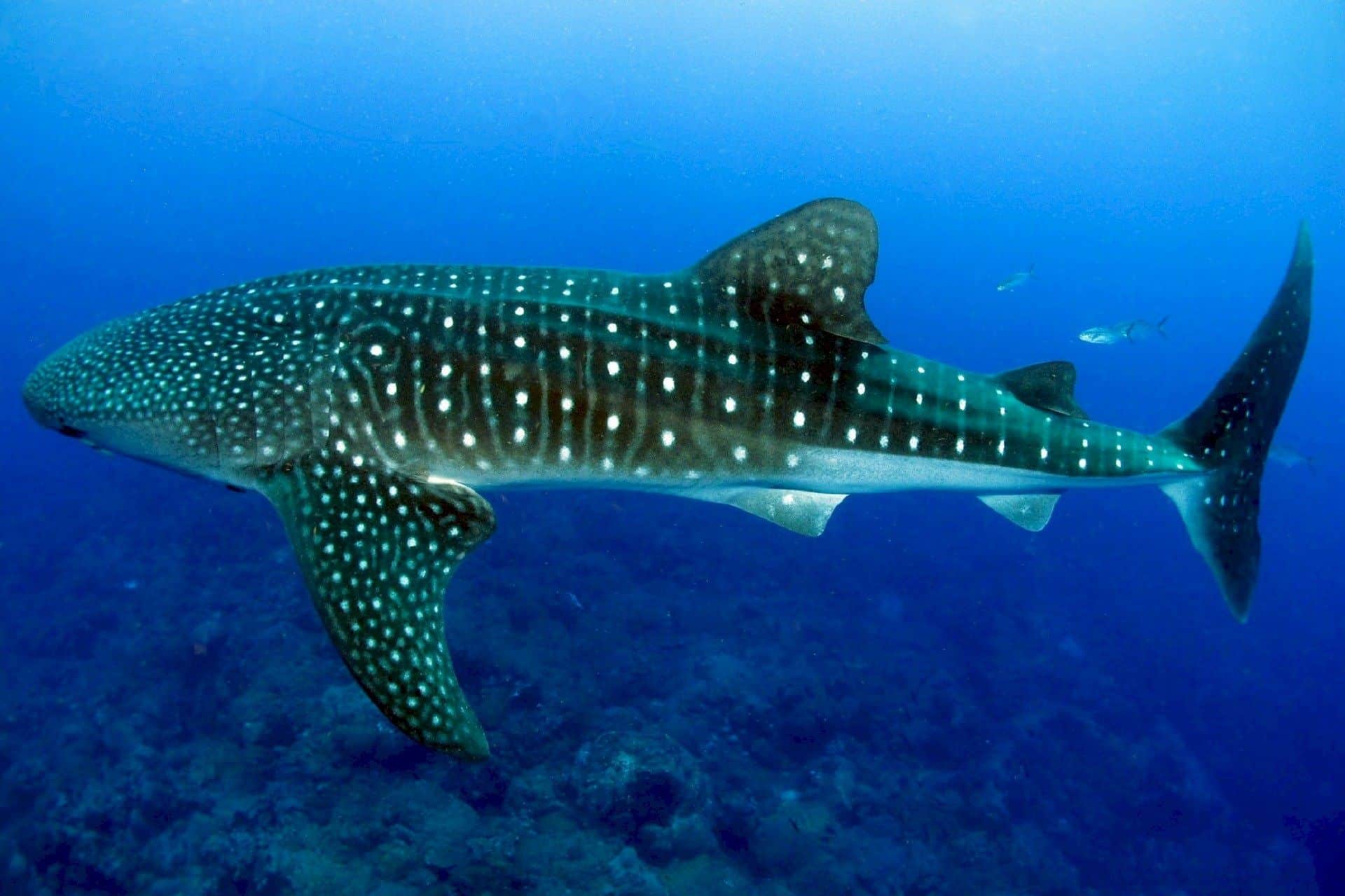
The whale shark can reach a length of up to 20 meters and a weight of more than 15 tons. It's as long as a bus and as heavy as three elephants. This makes it the largest living animal that does not have a spine. For comparison: the blue whale, the largest animal of all, can be up to 30 meters long and weigh 170 tons.
Despite its size, the whale shark is harmless to humans. It is not a predator, but a so-called filter feeder. This means that it feeds mainly on plankton. Plankton are tiny organisms that float in water. The whale shark also eats small fish and squid.
2. Blacktip Reef Shark
The blacktip reef shark is a fascinating and elegant species of fish found in tropical and subtropical waters. It belongs to the Requiem shark family and is best known for its distinctive black tips on its fins. Below I would like to tell you more about this shark, which is often found near coral reefs. What does a blacktip reef shark look like?
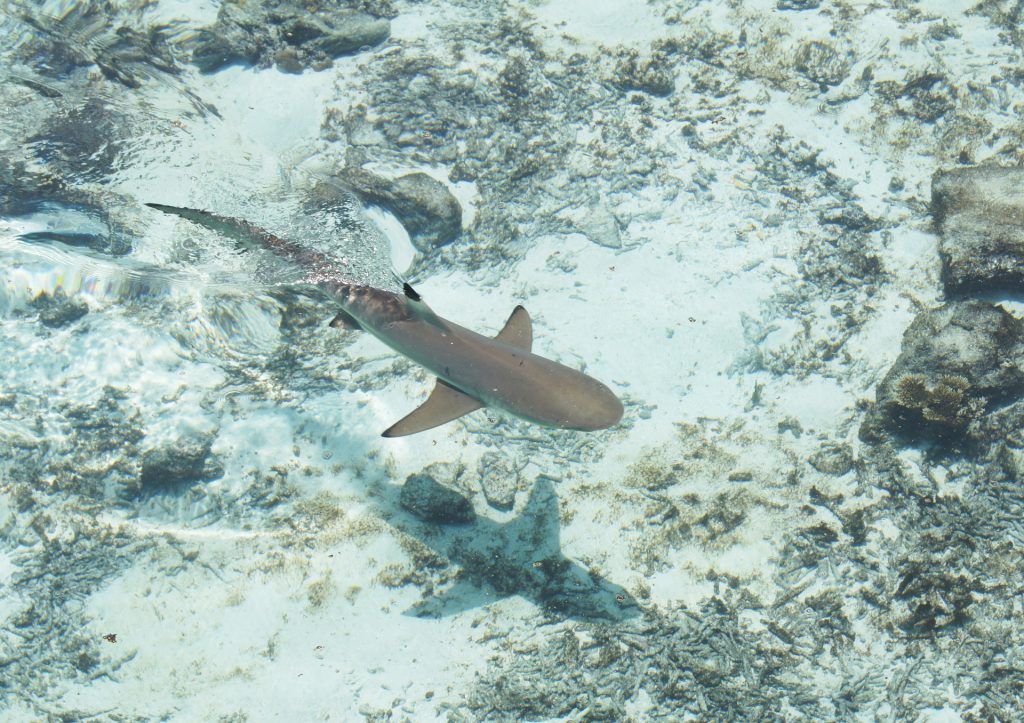
It has a slim and streamlined body that can grow between 160 and 200 centimeters long. Its snout is broad and blunt, and its eyes are relatively small. Its first dorsal fin is large and triangular, and it begins just behind the pectoral fins. Its second dorsal fin, on the other hand, is very small and sits far back on the body. Its caudal fin has a long upper lobe that accounts for almost half of the shark's total length.
3. Whitetip reef shark
Another distinctive member of this aquatic community is the whitetip reef shark (Triaenodon obesus). Easily identified by the white tips of its first dorsal and caudal fins, this elegant predatory fish is native to the warm, shallow waters of the Maldivian atolls.
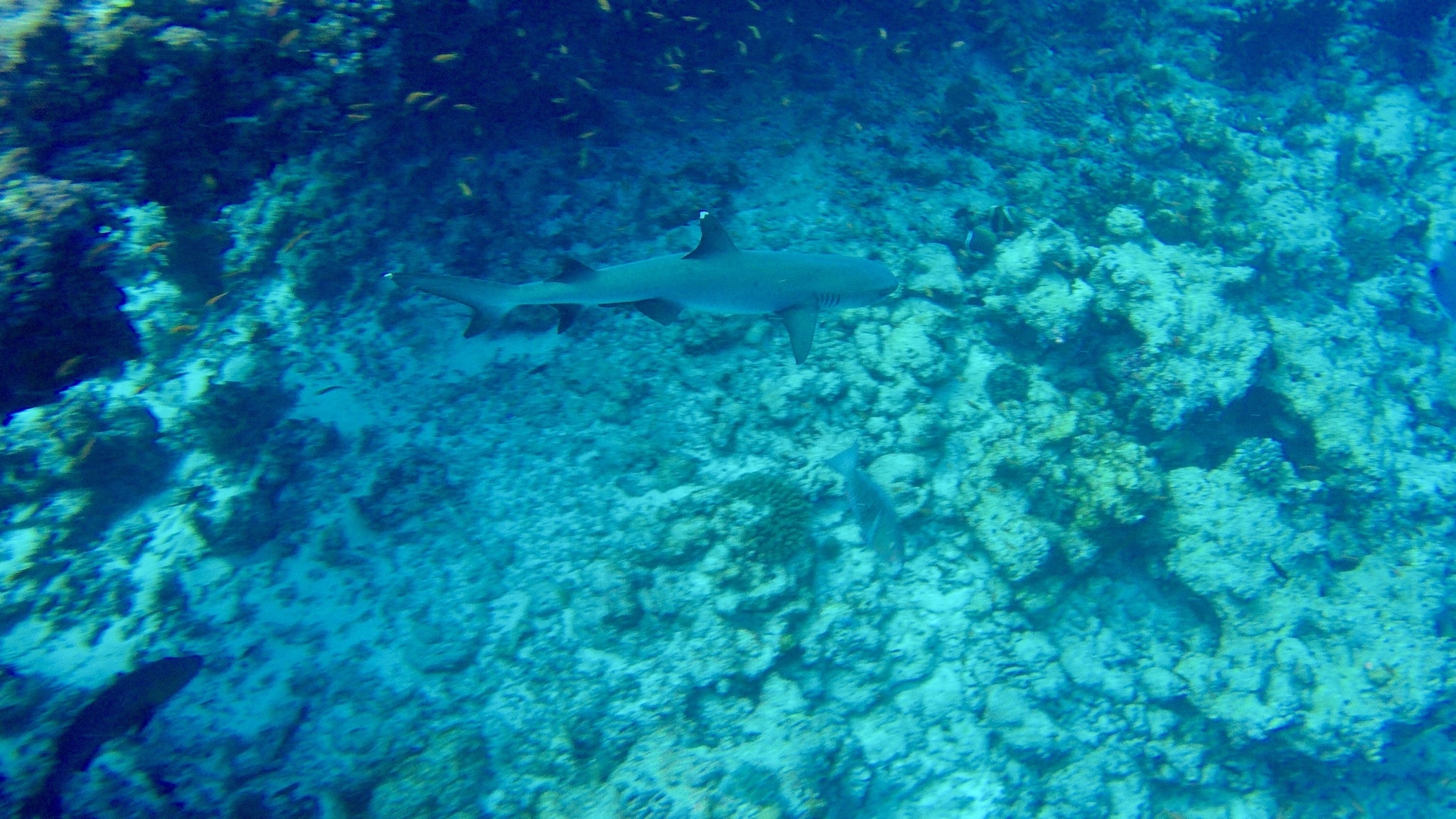
With an average size of around 1,5 meters, the whitetip reef shark is rather small compared to other shark species. Yet it has a slim, streamlined body that allows it to glide through the water with grace and speed.
What makes the whitetip reef shark particularly interesting, especially in the context of the Maldives, is its behavior and adaptability. It prefers coral reefs and is often found in caves and under overhangs where it rests during the day. It becomes more active at night and hunts smaller fish, crustaceans and squid.
4. Gray reef shark
The gray reef shark belongs to the requiem sharks, a group of sharks that live in warm seas. It is a medium-sized shark that feeds primarily on fish and other small animals. It is an active hunter, often lurking in groups for prey. He is also very territorial and defends his territory against intruders. The gray reef shark has a slim, streamlined body with a light gray upper surface and a white underside.
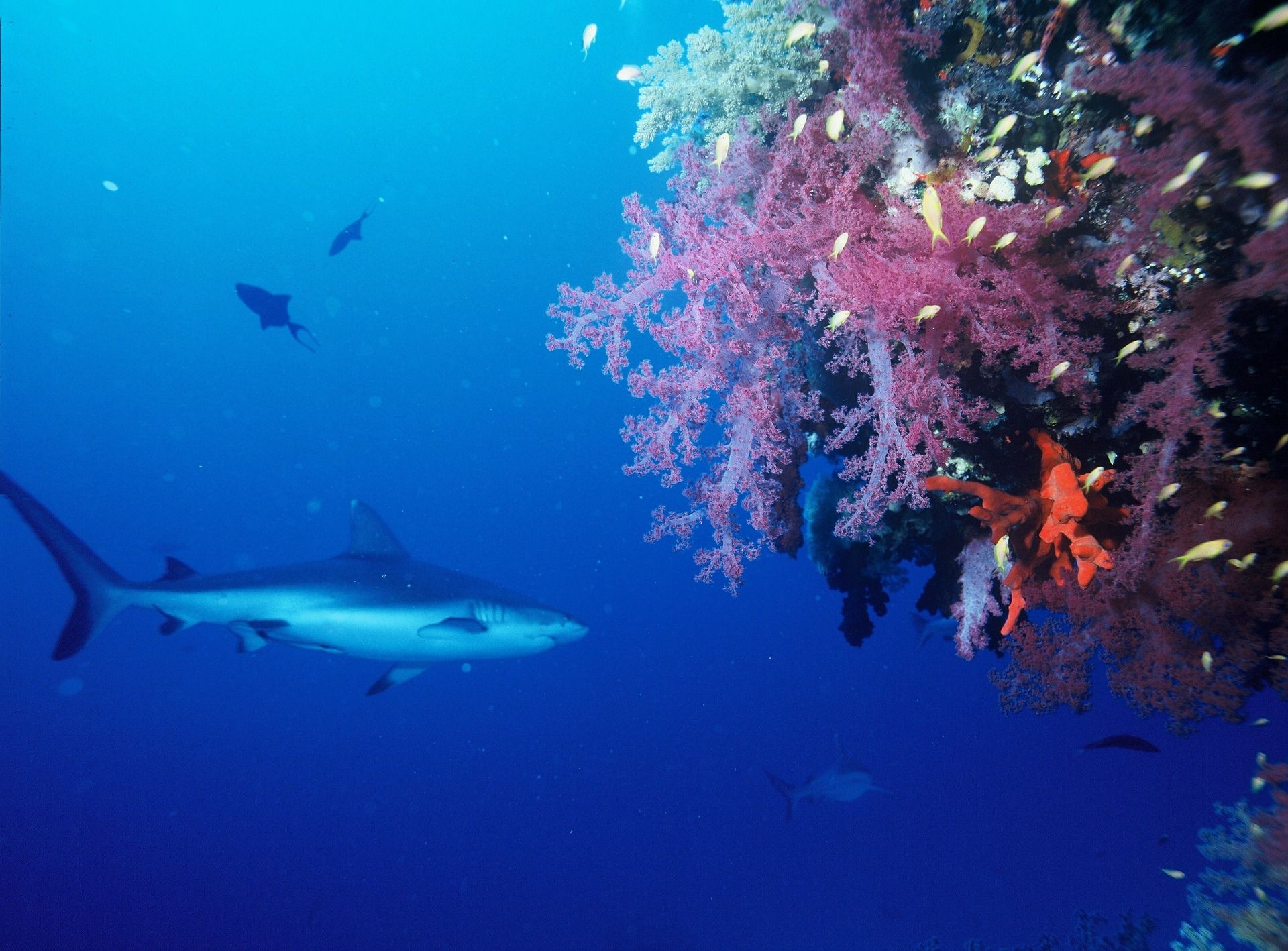
It also has some white spots and stripes on the sides of its body that help it camouflage itself in its surroundings. Its muzzle is long and rounded, its eyes are small and black. Its teeth are sharp and pointed, ideal for tearing flesh. Its first dorsal fin is large and triangular, its second dorsal fin is smaller and rounder. It does not have an interdorsal crest, a strip of skin between the dorsal fins, that many other requiem sharks have.
5. Tiger sharks
Tiger sharks are a fascinating species of shark that can inspire both admiration and fear. They are known for their curiosity and courage, but also for their aggressiveness. Below you can find out more about these impressive animals and how you can see them in the Maldives. Tiger sharks are among the largest and strongest sharks in the world.
They can grow up to six meters long and weigh over 600 kilograms. They have a powerful body, a broad head and distinctive markings reminiscent of a tiger. They are very adaptable and can live in different marine areas, from tropical to temperate waters.
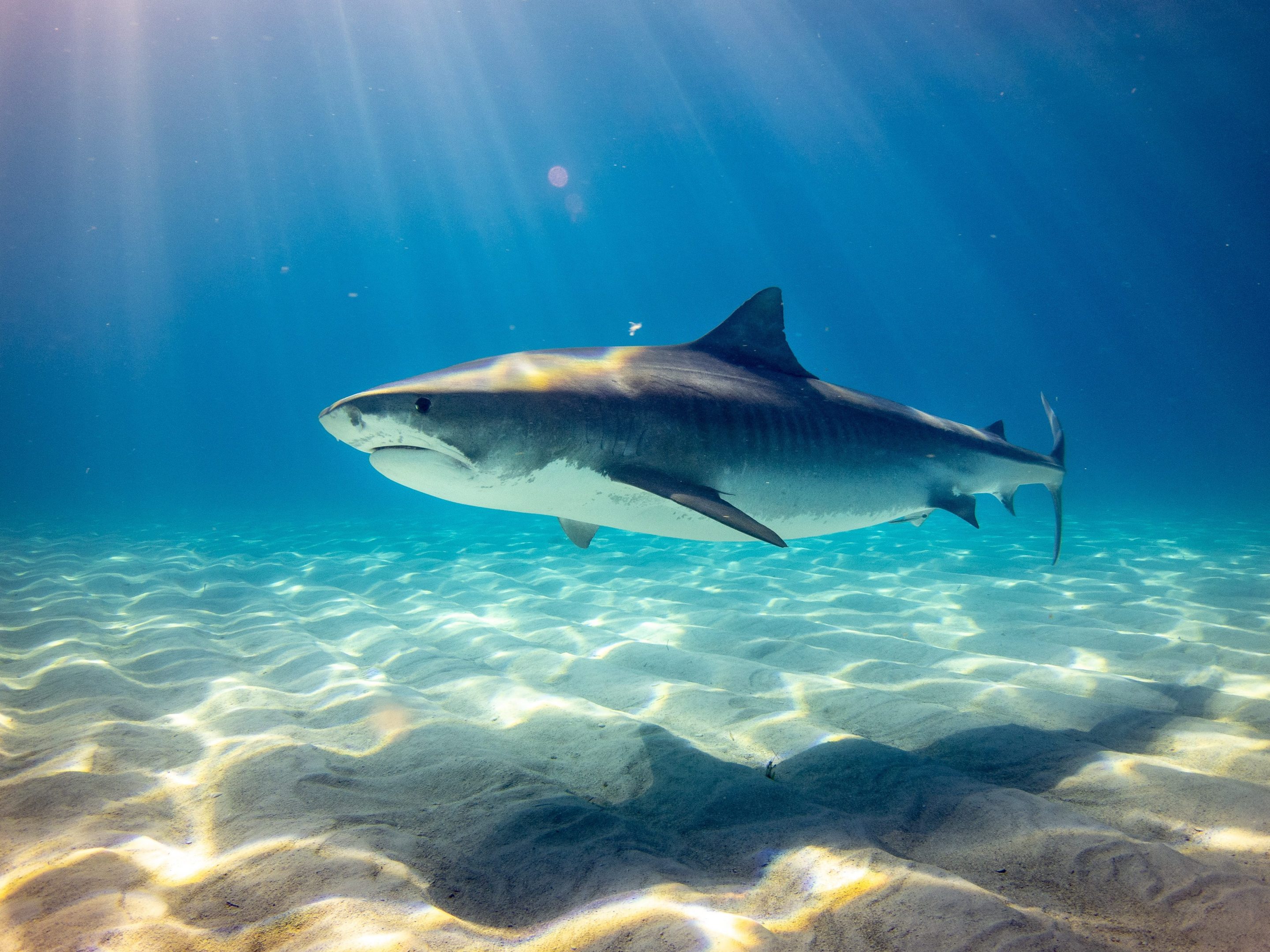
The huge predatory fish are also very versatile hunters, eating almost anything that comes in front of them. They feed on fish, turtles, seals, birds and even other sharks. They have a keen sense of smell and can detect blood from great distances. They are also very curious and enjoy examining unknown objects or creatures.
Unfortunately, this also makes them a potential danger to humans. Although tiger sharks typically have no interest in human flesh, they may sometimes perform what is known as a test bite out of curiosity or aggression. This means they bite a piece out of a human to taste what it is. Of course, this can have very serious consequences for humans, such as serious injuries or even death.
6. Bull sharks
One of the most impressive and at the same time most awe-inspiring members of the Maldives' underwater world is the bull shark (Carcharhinus leucas). They are known for their impressive size, powerful build, and broad, flat heads. These sharks can grow up to 3,5 meters long, making them one of the larger shark species.
Their reputation as one of the most aggressive sharks has made them notorious in the public eye. However, it is important to emphasize that bull shark incidents in Maldives waters are extremely rare.
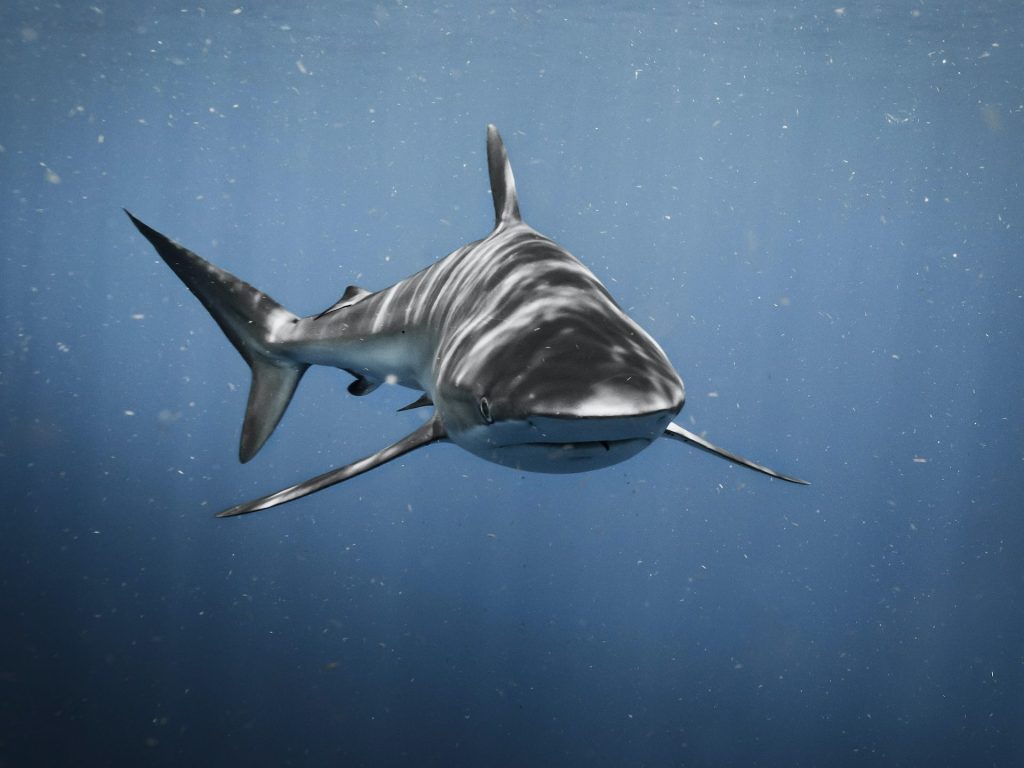
These formidable predators are present in the waters around the Maldives, although not as common as other shark species. They are known for their ability to survive in both salt and fresh water, making them one of the few shark species found in rivers and lakes as well as the ocean.
However, in the Maldives they are mainly found in deeper waters and near outer reefs. For divers, encountering a bull shark in the Maldives is an unforgettable experience that inspires both fascination and respect.
7. Silky Shark
Have you ever wondered how the silky shark lives? This fascinating fish is one of the largest and most elegant sharks in the world. It gets its name from its silky skin, which helps it move quickly and smoothly through the water. In this blog post you will learn more about the silky shark, its characteristics, habitat, diet and relationship with humans.
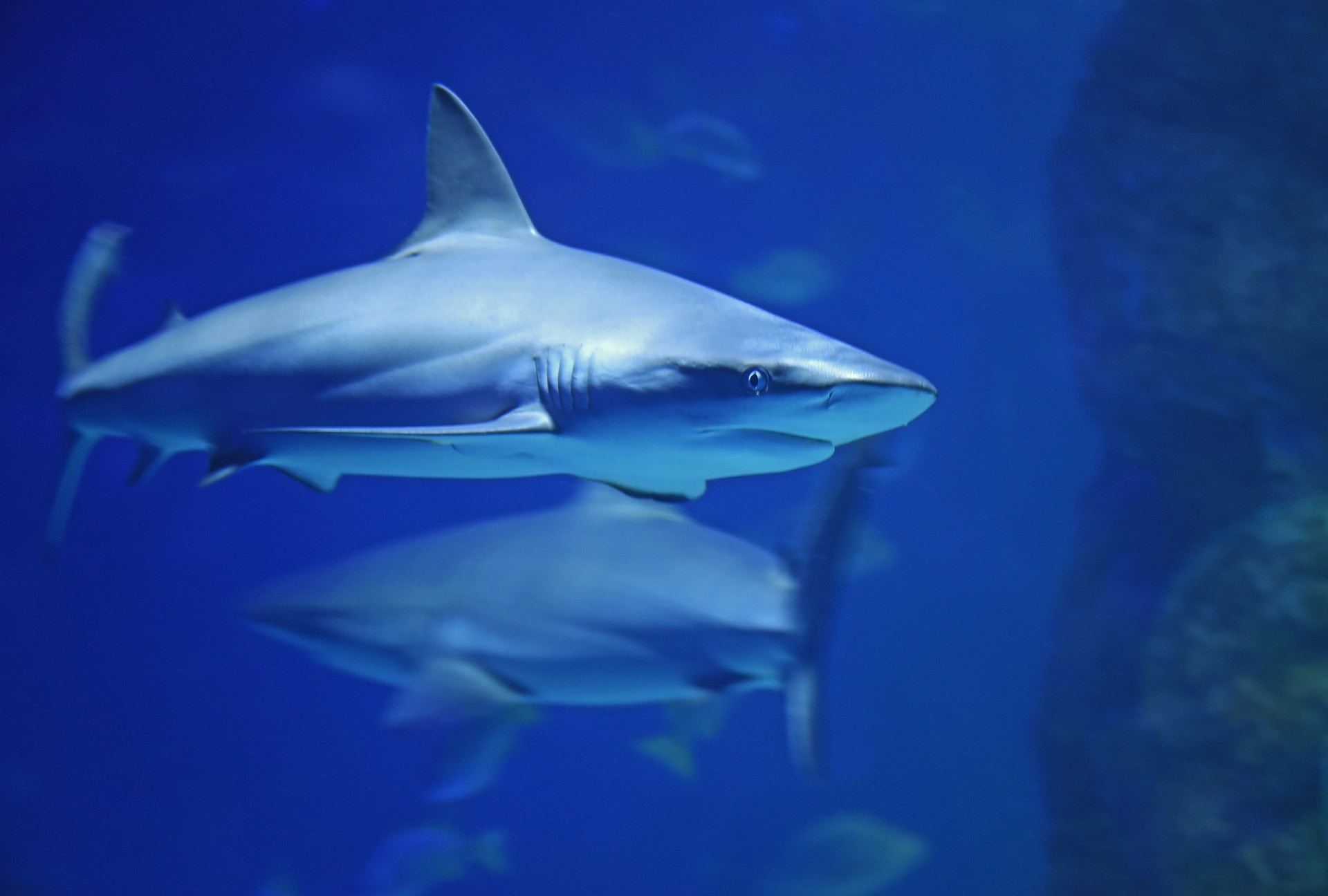
The silky shark belongs to the family of requiem sharks, which are characterized by five gill slits, a kidney-shaped eye opening and two dorsal fins. It is between 2 and 3,3 meters long and weighs up to 350 kilograms. Its body shape is slim and streamlined, with a moderately long, flat and rounded muzzle. Its eyes are large and black, giving it good vision in the dark. Its teeth are pointed and slightly curved backwards, ideal for grasping and holding onto prey.
8. Nurse sharks (Ginglymostoma cirratum)
Among the many marine creatures that inhabit the waters of the Maldives, the nurse shark (Ginglymostoma cirratum) deserves special attention. He is impressive not only because of his size and appearance, but also because of his unique behavior. The nurse shark, often referred to as the roundhead shark, differs in many ways from the stereotypical ideas that many people have of sharks.
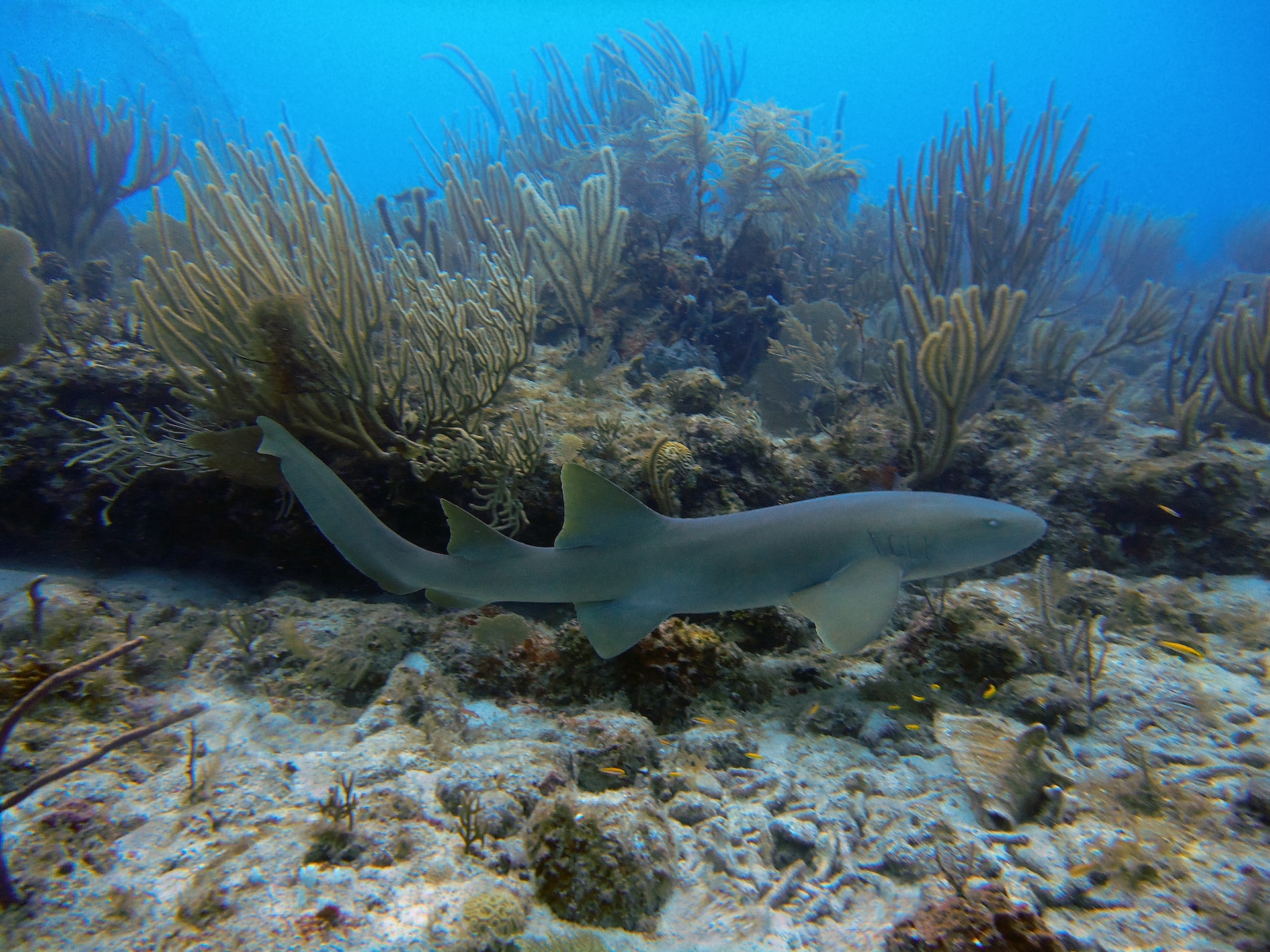
With an average length of 2 to 3 meters, the nurse shark has a massive body and a broad, flat head that gives it an almost amiable appearance. Its small eyes and barbels, which look like sensors, give it a distinctive appearance.

Follow me too Xing, TripAdvisor and Threads!
Follow me on Instagram now
stick with Travel Blog Just-Wanderlust.com and @strandkind_co always up to date and just follow me on Instagram!
Has anyone present already treated themselves to the new MacBook M3? And if so, what color? 💻🛒😍🤓
*Advertising / Ad*
#apple #macbook #macbookair #macbookairm3 #macbookair13

*Advertisement / Ad* The brand new MacBook Air M3 is here!
– With ultra-fast M3 processor 💨
– 18 hours of battery life 🔋
– Available in 13 and 15 inches 💻
– Only 1,24 kg light and 11,3 mm thin (13 inches)
– Ideal for working on the go and traveling 🧳😎🥰
– Perfect for photo & video editing and AI applications
– Open today apple.com/de or pre-order directly from tomorrow Apple Shop store 🛒
#apple #macbook #macbookair #macbookairm3 #macbookair13

*Advertisement / Ad* You don't know where to travel this summer yet? How about the paradisiacal Croatian island of Krk! Get advice from @sol.tours and @solvillas.eu, they know the best accommodations and most beautiful corners of the island 😍🤟🥰🐳🌍✈️🏄☀️⛵️😍🙏
*
*
*
* ->>>> also check the links in my bio 🤩
*
*
*
#strandkind #blogger #travelblogger #travel #travel
#travellust #travelmakeshappy #travelphotography
#travel fever #travelblog #microadventure #wanderlust
#adventure #nature #diewocheaufinstagram #urlaub
#vacation ready #holiday feeling #holiday at home
#holidaywithdog #holidaywithchildren
#travel #travelphotography #travelblogger
#traveltheworld #travelgram #traveling #croatia #visitkrk @visitkrkisland @visitmalinska

*Advertisement / Ad* You don't know where to travel this summer yet? How about the paradisiacal Croatian island of Krk! Get advice from @sol.tours and @solvillas.eu, they know the best accommodations and most beautiful corners of the island 😍🤟🥰🐳🌍✈️🏄☀️⛵️😍🙏
*
*
*
* ->>>> also check the links in my bio 🤩
*
*
*
#strandkind #blogger #travelblogger #travel #travel
#travellust #travelmakeshappy #travelphotography
#travel fever #travelblog #microadventure #wanderlust
#adventure #nature #diewocheaufinstagram #urlaub
#vacation ready #holiday feeling #holiday at home
#holidaywithdog #holidaywithchildren
#travel #travelphotography #travelblogger
#traveltheworld #travelgram #traveling #croatia #visitkrk @visitkrkisland @visitmalinska

*Advertisement / Ad* You don't know where to travel this summer yet? How about the paradisiacal Croatian island of Krk! Get advice from @sol.tours and @solvillas.eu, they know the best accommodations and most beautiful corners of the island 😍🤟🥰🐳🌍✈️🏄☀️⛵️😍🙏
*
*
*
* ->>>> also check the links in my bio 🤩
*
*
*
#strandkind #blogger #travelblogger #travel #travel
#travellust #travelmakeshappy #travelphotography
#travel fever #travelblog #microadventure #wanderlust
#adventure #nature #diewocheaufinstagram #urlaub
#vacation ready #holiday feeling #holiday at home
#holidaywithdog #holidaywithchildren
#travel #travelphotography #travelblogger
#traveltheworld #travelgram #traveling #croatia #visitkrk @visitkrkisland @visitmalinska

Never stop discovering - places, people, activities - and everything that lies within you⛷️🥰😍☀️🤟🥰🐳🌍✈️🏄☀️⛵️😍🙏
*
* Advertising
* Everything about the PillerseeTal in the link in the bio
*
*
*
*
#strandkind #blogger #travelblogger #shotoniphone #travel #travel
#travellust #travelmakeshappy #travelphotography
#travel fever #travelblog #microadventure #wanderlust
#adventure #nature #sealove #vacation
#readyforvacation #vacationfeeling
#holidaywithdog #holidaywithchildren #justwanderlust
#travel #travelphotography #travelblogger
#traveltheworld #travelgram #traveling

Poisonous Animals of the Maldives - Stonefish are deadly if you're not careful
While most sharks in the Maldives are fairly safe, in the realm of the atolls there are actually some really dangerous animals: stonefish. The well-camouflaged fish, which are hardly distinguishable from the ground, because they look like a mixture of stone and coral, are highly poisonous and potentially life-threatening. To make matters worse, they have no fear and do not disappear when someone approaches them. I have made my own experiences with the deadly and dangerous animals in the Maldives:

"During a dive on a reef in the Baa Atoll, we came in a very strong current, as is common in the Maldives. Because it could not be otherwise, I tried to reach for a coral with my hand to hold on to myself and not be aborted.
In this significant stress situation, I was not paying attention to where I'm going. After getting a coral, I see: A stonefish sits 20 inches away from my hand on the coral! Conversely, if I had moved a bit farther to the right, I would probably be dead! "
Sascha Tegtmeyer
Fortunately there was one back then marine biologist present who helped me out! Stonefish in the Maldives are not deadly per se. But stonefish can cause significant pain, paralysis and swelling. However, if you are a diver, you can easily panic due to the severe pain - this can ultimately lead to a diving accident because you may ascend too quickly.
But not only divers are endangered: even snorkelers in shallow water at the reef can of course come into contact with the wrinkled fish. And swimmers can also be affected if they go into the water from the beach and possibly step on a stone fish. So yes, Maldives stonefish can be deadly or at least hurt people very seriously. It is very careful and the contact should be avoided!
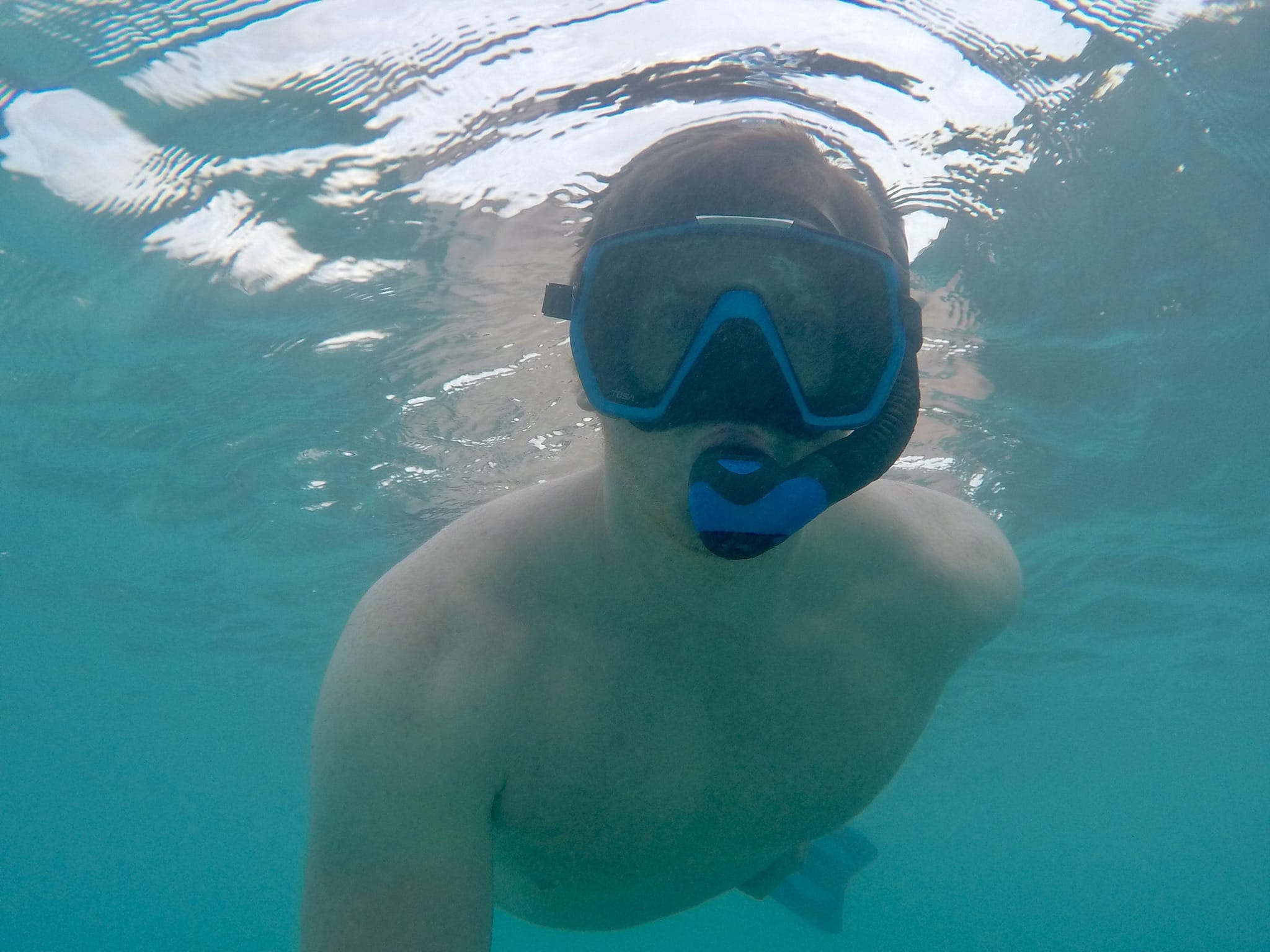
House reefs in the Maldives - Is snorkeling with sharks dangerous?
I've been asked several times whether snorkeling in the Maldives is dangerous and are sharks dangerous in the Maldives? The answer is a bit like someone asking me whether driving in Germany is dangerous. It is very clear: yes and no – and depends on the behavior of the individual. And that has the following reasons. Do you dream of snorkeling in the Maldives and discovering the fascinating underwater world?
Then you may have already thought about whether snorkeling in the Maldives is dangerous. Especially if you come across sharks. Below I would like to give you some tips on how to snorkel safely and relaxed with sharks and what else you should keep in mind to enjoy your snorkeling experience in the Maldives.
Snorkeling in the Maldives is not overly dangerous
Snorkeling in the Maldives is generally no more dangerous than in other tropical waters. Most sharks you may encounter here are harmless and curious. They have no interest in attacking or hurting you. On the contrary, they are often rather shy and keep their distance. But that doesn't mean you should provoke or feed them. Respect their distance and behave calmly and unobtrusively in the water.
The most common shark species you can see while snorkeling in the Maldives are blacktip reef sharks, whitetip reef sharks, gray reef sharks and nurse sharks. These sharks usually do not grow larger than two meters and feed mainly on fish and crustaceans. They are not a threat to humans as long as you don't get too close or corner them.
Stay calm during shark encounters in the Maldives
If you see a shark while snorkeling, stay calm and breathe evenly. Move slowly and don't try to swim after him or touch him. Instead, watch him from a safe distance and enjoy this special moment. You will notice how elegant and graceful these animals are. Maybe he'll look into your eyes for a moment before disappearing again.
If you're lucky, you might even see several sharks at the same time or even swim with them. This is an unforgettable experience that you shouldn't miss. But the same applies here: stick to the rules and respect the animals.
In addition to sharks, there are other dangers when snorkeling in the Maldives that you should not underestimate. For example, currents that can pull you away from the reef. That's why you should always have a life jacket or buoyancy aid with you and stick to your guide or group. You should also be careful about where you step or what you touch. There are some poisonous or spiny animals in the reef, such as stonefish or triggerfish, that can hurt you if you touch them or get too close to them.
Snorkeling in the Maldives is a wonderful experience that you shouldn't miss. If you follow these tips, you can snorkel with sharks safely and relaxed and admire the beauty of the underwater world.
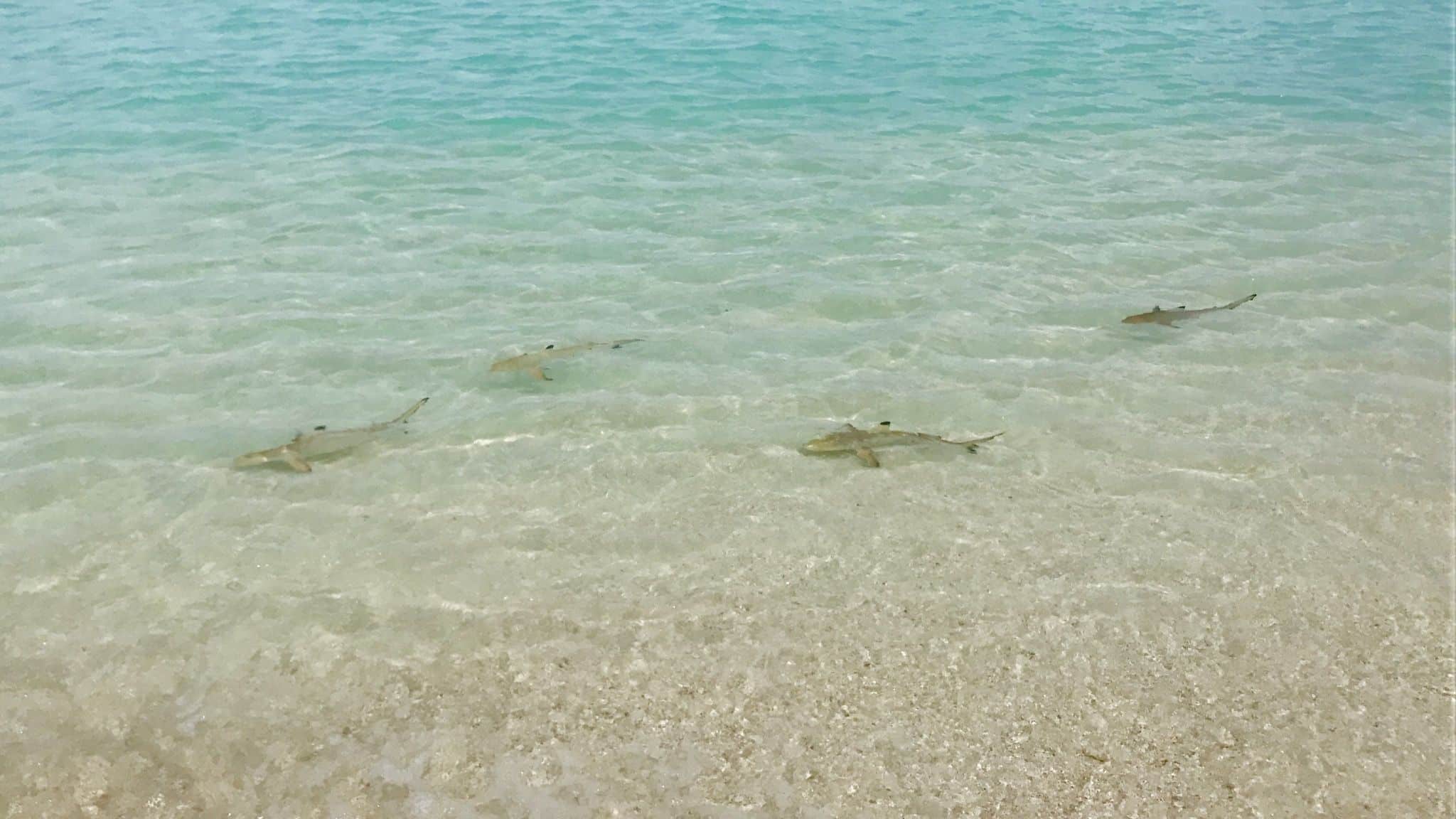
Baby sharks in the Maldives on the beach
When I stepped onto the jetty of my resort island for the first time on my Maldives trip, I could hardly believe my eyes: directly below me there were several baby sharks cavorting in the crystal clear water. They were young blacktip reef sharks, one of the most common shark species in the area.
But why were they so close to the shore? I later learned that the baby sharks find a safe habitat here, where they are protected from larger predatory fish. There is also enough food for them here, such as small fish and crustaceans. The mother sharks lay their eggs in the coral reefs and only occasionally come by to check on their young.
Baby sharks on the jetty fascinated me
I was fascinated by this natural spectacle and couldn't get enough of watching the baby sharks. They were very curious and often came very close to me. Sometimes I could even see their dorsal fins sticking out of the water. They weren't aggressive or dangerous at all, but rather playful and cute.
I took some photos of the baby sharks for you, which you can check out below. Maybe you'll have the opportunity to experience these wonderful animals live. I can only tell you that it was one of the most beautiful experiences of my life. I will never forget the baby sharks in the Maldives.
Related Articles
Sharks in the Maldives – up close with the graceful predatory fish
My conclusion
Sharks are threatened worldwide. I would therefore like to stand up for the majestic predatory fish in order to create awareness among people about this endangered species. We have therefore already reported extensively on sharks in Thailand and also on the shark species in the Red Sea.
The great white shark in particular is viewed as an enemy by many people because they feel threatened by it. The grotesque thing is: Less than a dozen people die from sharks every year - but the number of large fish killed is in the 100 million animals. Unfortunately, this is completely overlooked: If the shark dies out, the food chain on the planet will be completely disrupted - and then humans will ultimately die too.
Have you ever been to the Maldives or are you planning a trip? Have you already been diving with sharks and seen some in the open sea? Share your experiences in the comments!


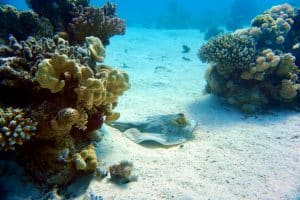
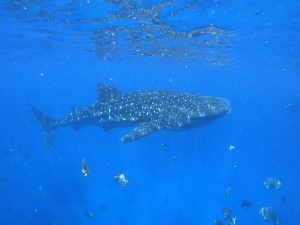
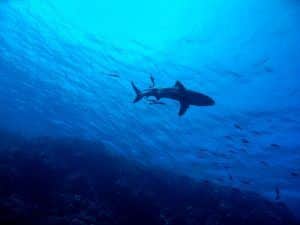

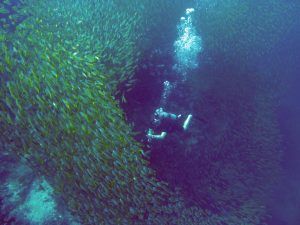
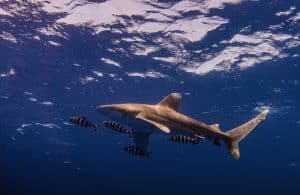
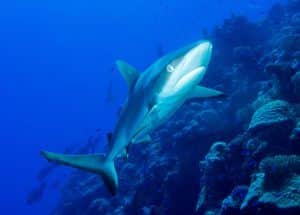
Oh, I envy you already, on the Canary Islands, there are only very rarely sharks to see and if it is usually the angel shark.
Ronny,
Yes that's true. But an angel shark is not bad either! And whales and dolphins can also be seen in the Canaries .. I was last two years ago on the Canaries dive and I thought it was fish-technically really nice, so it was really good going on underwater ..
Sunny greetings from Hamburg
Sascha
Hello, great article thanks. Only one correction I have to suggest. Roller spiders do not have venom glands. They kill their prey with the very strong jaw claws and then vomit a kind of digestive secretion which decomposes the prey so that the spider can absorb this porridge.